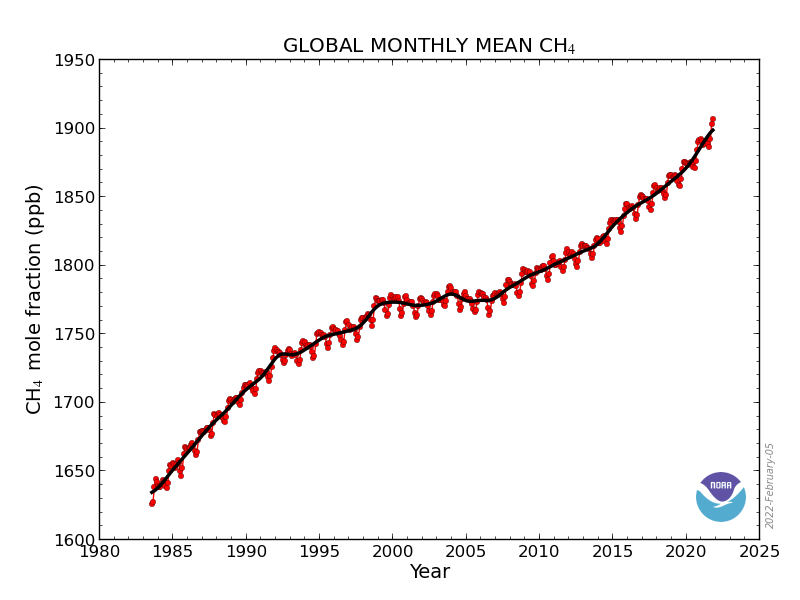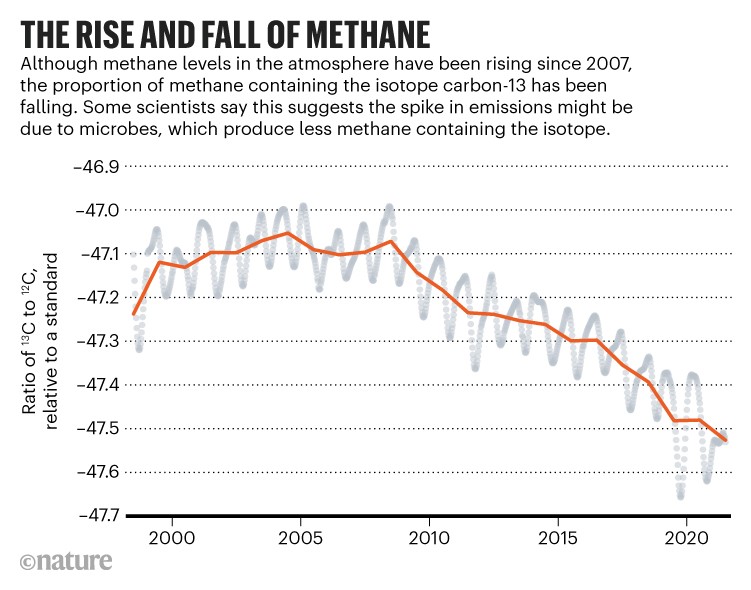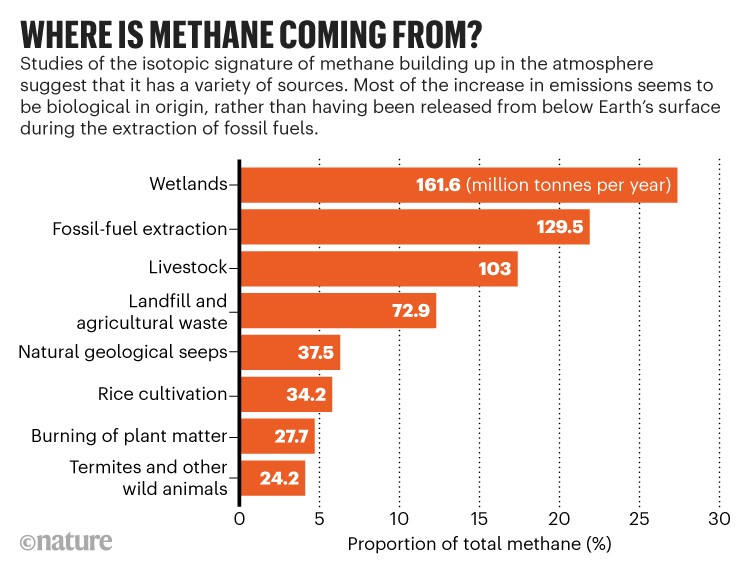An alarm is being raised concerning a big increase of Methane within our Atmosphere. The fear is that we have crossed a tipping point and that vast amounts of methane are being released from wetlands because of warming.
NOAA Data
That latest data we have comes via the January update from NOAA.
First let’s take a look to see what has been measured in the last four years …

The red line shows the monthly measurements. The black line is the averaged out long term trend.
KEY POINT 1 – concentrations in the atmosphere of Methane raced past 1,900 parts per billion last year.
That is unprecedented. For context, over the last 400,000 years, it has been roughly 300-400 during glacial periods and 600-700 during interglacial periods.
1,900 is a jaw dropping number in that context.
But that’s Methane not CO2
Well yes, CO2 does indeed gather all the fan mail and hence it attracts all the media attention. So why is such a rise in CH4, methane, such a big deal?
The issue is this – As a greenhouse gas, it is roughly about 20-30 times more potent than CO2.
When you step back and consider the big picture, we are spewing out greenhouse gases. This leads to a change in the Earth’s energy balance.
In simple terms, we get energy from the sun, and we also lose energy back out into space. That’s the energy balance.
The change to this that is driven by climate change is termed “Radiative forcing“. This is a measurement of a change in the energy balance. To put that another way, with more greenhouse gases we get to keep more of the energy from the sun and so the climate warms.
KEY POINT 2 – when it comes to the amount of warming (or radiative forcing), then yes, CO2 is indeed mostly responsible, but after CO2, next up is Methane being responsible from about 20% of it.
In other words, while the amount of Methane is tiny when compared to CO2, the fact that it is a far more potent greenhouse gas means that it is a big player within the context of the big picture.
So back to that racing beyond 1,900 … one word – “Yikes”.
In Context
Let’s step back a bit and see what has been happening over the last 40 or so years …

What you can see from the above is that we were successfully flattening the curve, then suddenly around 2007, something happened, and the CH4 (Methane) rates started to rapidly rise and accelerate.
The fear is this – we hit a tipping point. The thinking is that because of the increasing warming, a feedback mechanism is now releasing ever increasing volumes of CH4 …
“Methane levels are growing dangerously fast,” says Euan Nisbet, an Earth scientist at Royal Holloway, University of London, in Egham, UK. The emissions, which seem to have accelerated in the past few years, are a major threat to the world’s goal of limiting global warming to 1.5–2 °C over pre-industrial temperatures, he says.
If this fear is indeed correct, then it means that the challenge we face on the road ahead will be rather more challenging than we might initially anticipate.
Where is all this Methane coming from?
Right now that is not robustly clear.
There are however some very strong signals.
Most Carbon is what is known as Carbon-12. There is also another type of carbon called Carbon 13. That represents just 1.1% of all carbon, a tiny fraction.
It is called C13 because it has 6 protons and 7 neutrons. For comparison , C12 only has 6 of each, so here we have an extra neutron.
Methane contains Carbon – both C12 and also C13.
If methane is naturally generated by the heat and pressure inside the earth, then there is a specific proportion of C12 and C13 within that methane.
However, methane that is generated by life, for example cow farts or bugs in wetlands, then the amount of C13 is lower. This is because biologically produced methane prefers C12 (Biological processes preferentially take up the lower mass isotope through kinetic fractionation)
Now here comes the kicker …

Since 2007, the time when methane levels started to spike rapidly upwards, the proportion of C13 has gone downwards.
This is a rather strong hint that the methane spike is biological in origin.
To put that another way, it is not us fracking or drilling for fossil fuels releasing it, but instead it is being generated by life.
“It’s a powerful signal,” says Xin Lan, an atmospheric scientist at NOAA’s Global Monitoring Laboratory in Boulder, Colorado, and it suggests that human activities alone are not responsible for the increase. Lan’s team has used the atmospheric 13C data to estimate that microbes are responsible for around 85% of the growth in emissions since 2007, with fossil-fuel extraction accounting for the remainder5.
What are we sure of, and what is still a question?
What we are sure about is this …
- Methane is a very potent greenhouse gas
- The quantity of methane has spiked upwards since 2007 and that extra methane is biological in origin
The key question is perhaps this
- Is this being driven by warming, for example due to wetlands becoming more biologically active?
Recent measurements do reveal the methane sources to be as follows …

Line two there s rather obviously us, so we don’t duck responsibility here.
An article in Nature reveals …
Carbon Mapper and the Environmental Defense Fund, an advocacy group in New York City, released data revealing that 30 oil and gas facilities in the southwestern United States have collectively emitted about 100,000 tonnes of methane for at least the past three years, equivalent to the annual warming impact of half a million cars. These facilities could easily halt those emissions by preventing methane from leaking out
So yes, there are indeed actions that we can and should do.
COP26 saw many nations sign up to the Global Methane Pledge – a promise to cut emissions by 30% from 2020 levels by 2030.
That is indeed a good start if achieved.
That still leaves a deep fear that a tipping point has already been passed. The one strand of comfort is that this is not confirmed. In the minds of those that hold such thoughts, being wrong has become a deeply desired outcome.